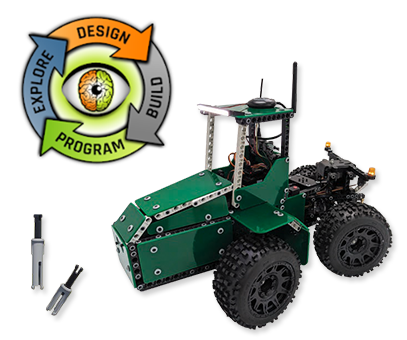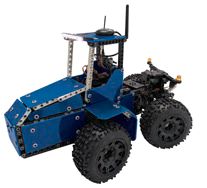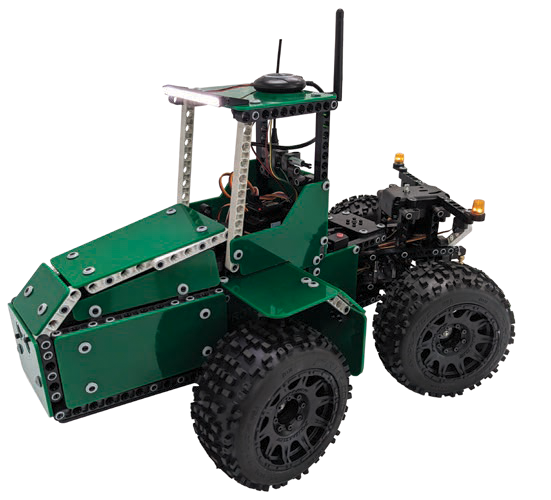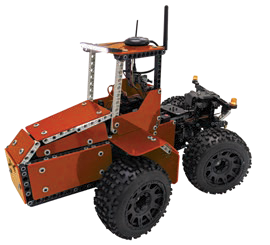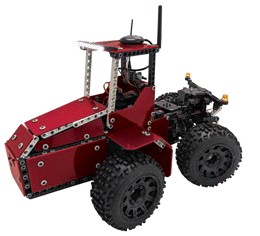Self-Driving Tractor Lab
Take STEM learning to new heights with this cutting-edge GPS–IMU-powered tractor. Students explore programming, electromechanical systems, and autonomous navigation. Students design, build, and program the tractor for ground-based crop evaluation, spraying, spreading, crop monitoring, and other compelling farming-related challenges.
Spark and Sustain Student's Interest in STEM
MINDS-i Robotics engages students in an energizing STEM learning environment with easy-to-build, program, and modify robots. Technologically advanced farm vehicles perform impressive real-world tasks that build excitement for STEM careers. The curriculum encourages collaborative, problem-solving, and the open-source C++, Python, or ROS-compatible programming language fosters endless creativity. With outstanding technical support, teachers are empowered, and students are inspired to build whatever they envision in their “mind’s eye.
Course Design
This lab is a half-semester (45 Hours) designed for 2-4 students.
Curriculum Outline
Unit 1: Introduction to Autonomous Vehicles
- Student Performance
- What is an Autonomous Vehicle
Unit 2: Autonomous Self-Driving Tractor
- Self-Driving Tractors; Levels of Autonomy
- Self-Driving Tractors; Current and Future Use Cases
Unit 3: Autonomous Tractor Technologies
- Self-Driving Tractors; Localization
- GPS Navigation
- Inertial Measurement Unit (Gyro, Accelerometer, Compass)
- Encoder (Cruise Control)
- Localization (Cross-Track Error)
- Self-Driving Tractors; Communication
- Control Systems
- Object Detection & Avoidance
Unit 4: Electrical Engineering & Energy Transfer
- Energy Types & Transfer
- Electric Motors
- How They Work & Benefits
- Batteries
- Usage, Maintenance, Technologies
Unit 5: Applied Systems Thinking
- Inputs, Outputs and Constraints
- Interrelationship Diagrams
Unit 6: Culminating Projects; Automated Farming
- Ground Prep
- Planting
- Fertilizing
- Watering
- Harvesting
Minds-i Dashboard Software & Mega 2560 hardware
- Open Source Software / Windows 10, OS X & Linux Ready, Easy to use Graphical Interface
- Drag and Drop Installation (w/Radio Driver)
- Save and Load GPS Paths, Capable of Navigating to 100 Waypoints
- Live Location Tracking and Wirelessly Adjust Settings
- Customizable Graphs: Latitude, Longitude, Yaw/Direction, Pitch, Roll, Ground Speed, Voltage, Amperage and Altitude
- Full Telemetry Logging and Inclinometer Gauges
More Information
Agriculture, Food & Natural Resources
![]() Agriculture can be considered one of the oldest industries in th world tracing its origin back 12,000 years. What started with small groups of people in various locations figuring out how to domesticate animals and grow their food has become a multi-trillion-dollar global industry.
Agriculture can be considered one of the oldest industries in th world tracing its origin back 12,000 years. What started with small groups of people in various locations figuring out how to domesticate animals and grow their food has become a multi-trillion-dollar global industry.
Over the last few centuries, sparked by a series of industrial revolutions, significant changes have taken place throughout the industry that has shaped agriculture as we know it today. Machinery has replaced manual processes and hand tools. Additionally, technological advances, including computers and the Internet, have enabled agricultural machines and procedures to be more productive and efficient.
As technology continues to advance, agriculture must keep evolving to ensure that productivity keeps pace with an ever-expanding world population. Today’s agricultural experts need experience with more types of technology than ever before.
Agricultural mechanics is a critical component of robust and relevant agriscience programs. With the right equipment, educators can demonstrate how to construct and repair equipment, buildings, and facilities by following architectural and mechanical plans, show mechanical equipment and power systems, and teach hydraulic and pneumatic systems service and repair.
Plants, farms, and animals are the main functions of agriculture. Still, there are additional opportunities in this field. This career pathway covers a variety of careers - ranging from animal science and veterinary science to metal technologies/welding, oil and gas production systems, and energy & natural resources.
Students need the opportunity to apply physical science principles to their studies with an agricultural mechanics career track that covers:
- Agricultural systems including equipment, power systems, alternative fuel sources and precision technology
- Welding trainers, CNC tables, and hydraulics training systems are all key components to the formula that makes up a robust educational program
- Food Production & Processing Systems
- Natural and Rewable Resource Systems
- Animal Systems, Veterinary Programs

